麦肯锡案例分析技巧
- 格式:doc
- 大小:32.00 KB
- 文档页数:4
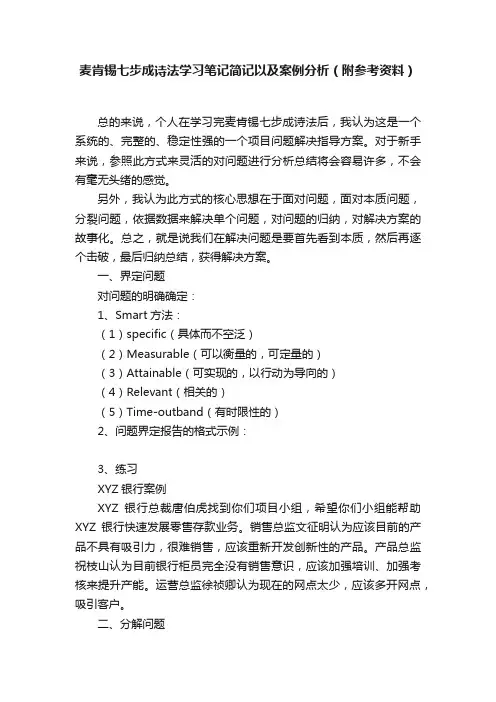
麦肯锡七步成诗法学习笔记简记以及案例分析(附参考资料)总的来说,个人在学习完麦肯锡七步成诗法后,我认为这是一个系统的、完整的、稳定性强的一个项目问题解决指导方案。
对于新手来说,参照此方式来灵活的对问题进行分析总结将会容易许多,不会有毫无头绪的感觉。
另外,我认为此方式的核心思想在于面对问题,面对本质问题,分裂问题,依据数据来解决单个问题,对问题的归纳,对解决方案的故事化。
总之,就是说我们在解决问题是要首先看到本质,然后再逐个击破,最后归纳总结,获得解决方案。
一、界定问题对问题的明确确定:1、Smart方法:(1)specific(具体而不空泛)(2)Measurable(可以衡量的,可定量的)(3)Attainable(可实现的,以行动为导向的)(4)Relevant(相关的)(5)Time-outband(有时限性的)2、问题界定报告的格式示例:3、练习XYZ银行案例XYZ银行总裁唐伯虎找到你们项目小组,希望你们小组能帮助XYZ银行快速发展零售存款业务。
销售总监文征明认为应该目前的产品不具有吸引力,很难销售,应该重新开发创新性的产品。
产品总监祝枝山认为目前银行柜员完全没有销售意识,应该加强培训、加强考核来提升产能。
运营总监徐祯卿认为现在的网点太少,应该多开网点,吸引客户。
二、分解问题两种主要的逻辑树:1、议题树案例:2、假设树案例:3、XYZ银行案例问题分解三、问题排序(漏斗过滤)在我看来,对问题排序就是要找到我们付出一定努力解决问题之后能够获得最大收益的项目。
可用方法:80/20法则(付出20%的努力能够获得对解决问题80%的帮助)案例参考:四、分析议题联系议题界定和实际分析工作之间的纽带进行更深层次的分解,确认各子议题和所需的分析工作向“星期一早晨我该做什么”的答案又跨近一步XYZ银行案例分析议题(仅分析案例中的一个小议题)五、关键分析针对各个关键因素,解决的手段是什么。
六、归纳建议把零散的研究成果归纳成为一个主要观点。
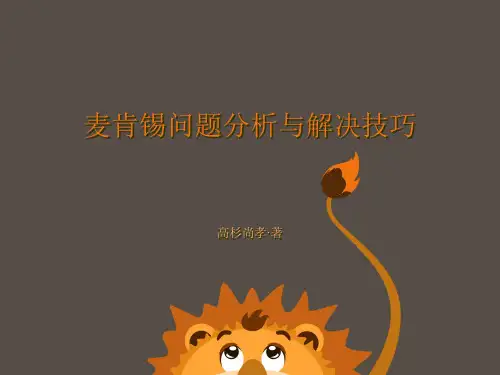
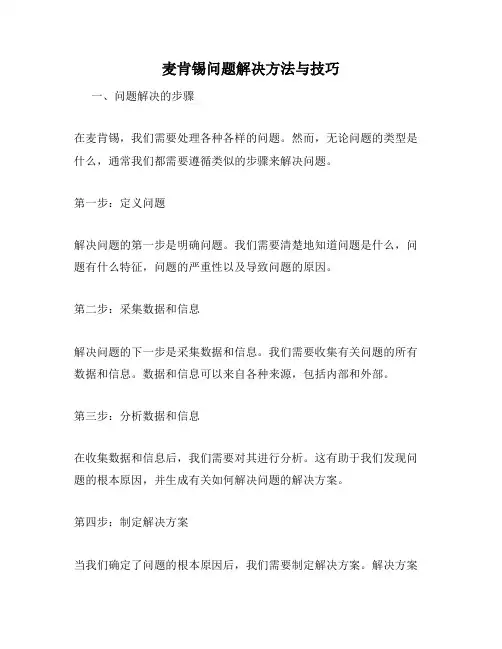
麦肯锡问题解决方法与技巧一、问题解决的步骤在麦肯锡,我们需要处理各种各样的问题。
然而,无论问题的类型是什么,通常我们都需要遵循类似的步骤来解决问题。
第一步:定义问题解决问题的第一步是明确问题。
我们需要清楚地知道问题是什么,问题有什么特征,问题的严重性以及导致问题的原因。
第二步:采集数据和信息解决问题的下一步是采集数据和信息。
我们需要收集有关问题的所有数据和信息。
数据和信息可以来自各种来源,包括内部和外部。
第三步:分析数据和信息在收集数据和信息后,我们需要对其进行分析。
这有助于我们发现问题的根本原因,并生成有关如何解决问题的解决方案。
第四步:制定解决方案当我们确定了问题的根本原因后,我们需要制定解决方案。
解决方案必须切实可行,可操作,并具有可行性。
解决方案必须充分考虑到各方面的利益,以及所需的资源,成本和时间。
第五步:执行解决方案制定解决方案后,我们需要执行解决方案。
这意味着我们需要实施我们制定的计划,并开始解决问题。
第六步:评估解决方案效果最后一步是评估解决方案的效果。
评估解决方案的效果可以帮助我们了解是否已成功解决了问题,并找到改进解决方案的机会。
二、问题解决的技巧在解决问题时,以下技巧可以帮助我们更高效地工作。
1. 问询技巧问询技巧是搜集数据和信息的重要方法。
好的问询技巧基本上涵盖了有效的提问和成果的记录两方面。
通过问询技巧,我们可以有效地发现信息,进而处理问题。
2. 分析技巧分析技巧包括分类,比较和对比,探索和挖掘等。
有效的分析技巧可以帮助我们深入理解问题,并确定其解决方案。
3. 管理时间技巧时间管理技巧是解决问题的关键。
它包括合理的计划,时间的分配和合适的跟进等。
有效的时间管理可以让我们在解决问题时更高效地工作。
4. 角色技巧角色技巧指在不同角色下的解决问题。
例如,作为一名领导者时,我们需要拥有领导的技巧和特质,如组织能力,指导能力和沟通能力等。
这可以帮助我们更好地领导问题解决过程。
5. 合作技巧在问题解决过程中,合作技巧是至关重要的。
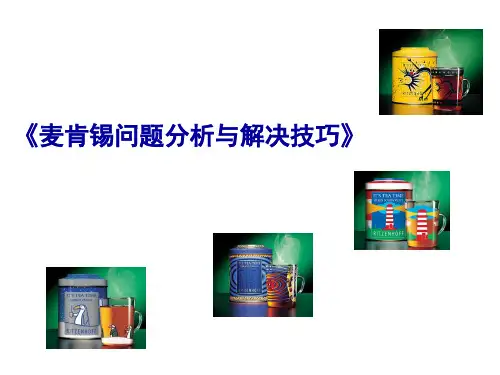
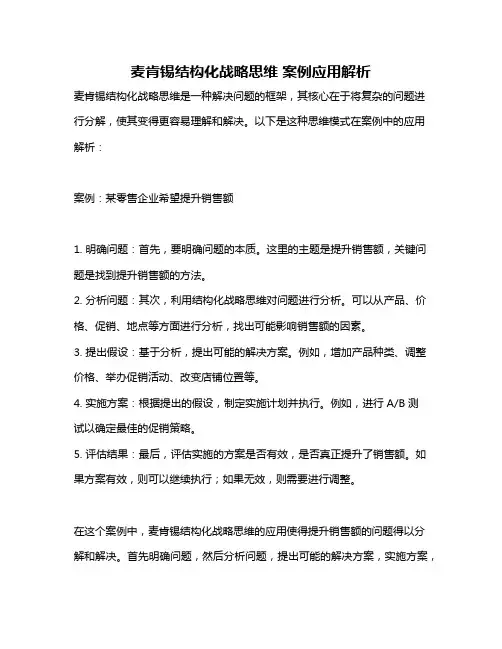
麦肯锡结构化战略思维案例应用解析
麦肯锡结构化战略思维是一种解决问题的框架,其核心在于将复杂的问题进行分解,使其变得更容易理解和解决。
以下是这种思维模式在案例中的应用解析:
案例:某零售企业希望提升销售额
1. 明确问题:首先,要明确问题的本质。
这里的主题是提升销售额,关键问题是找到提升销售额的方法。
2. 分析问题:其次,利用结构化战略思维对问题进行分析。
可以从产品、价格、促销、地点等方面进行分析,找出可能影响销售额的因素。
3. 提出假设:基于分析,提出可能的解决方案。
例如,增加产品种类、调整价格、举办促销活动、改变店铺位置等。
4. 实施方案:根据提出的假设,制定实施计划并执行。
例如,进行A/B测
试以确定最佳的促销策略。
5. 评估结果:最后,评估实施的方案是否有效,是否真正提升了销售额。
如果方案有效,则可以继续执行;如果无效,则需要进行调整。
在这个案例中,麦肯锡结构化战略思维的应用使得提升销售额的问题得以分解和解决。
首先明确问题,然后分析问题,提出可能的解决方案,实施方案,
最后评估结果。
这样的流程使得复杂的问题变得更容易解决,提高了解决问题的效率和质量。
以上内容仅供参考,更多麦肯锡案例分析可以咨询管理咨询专业人士了解。

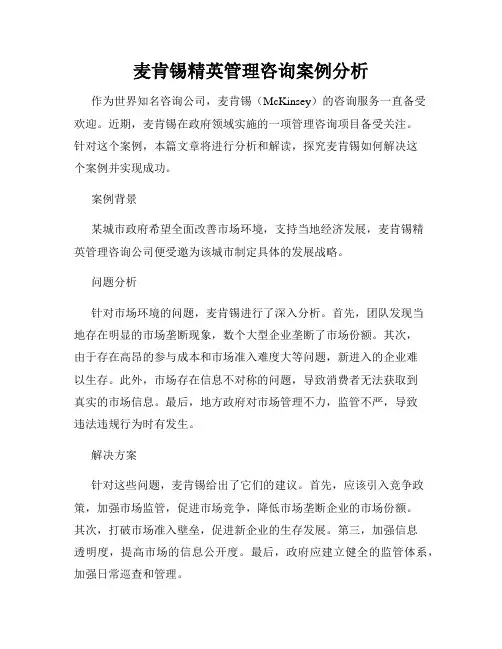
麦肯锡精英管理咨询案例分析作为世界知名咨询公司,麦肯锡(McKinsey)的咨询服务一直备受欢迎。
近期,麦肯锡在政府领域实施的一项管理咨询项目备受关注。
针对这个案例,本篇文章将进行分析和解读,探究麦肯锡如何解决这个案例并实现成功。
案例背景某城市政府希望全面改善市场环境,支持当地经济发展,麦肯锡精英管理咨询公司便受邀为该城市制定具体的发展战略。
问题分析针对市场环境的问题,麦肯锡进行了深入分析。
首先,团队发现当地存在明显的市场垄断现象,数个大型企业垄断了市场份额。
其次,由于存在高昂的参与成本和市场准入难度大等问题,新进入的企业难以生存。
此外,市场存在信息不对称的问题,导致消费者无法获取到真实的市场信息。
最后,地方政府对市场管理不力,监管不严,导致违法违规行为时有发生。
解决方案针对这些问题,麦肯锡给出了它们的建议。
首先,应该引入竞争政策,加强市场监管,促进市场竞争,降低市场垄断企业的市场份额。
其次,打破市场准入壁垒,促进新企业的生存发展。
第三,加强信息透明度,提高市场的信息公开度。
最后,政府应建立健全的监管体系,加强日常巡查和管理。
实施效果麦肯锡的这些建议被市政府所采纳。
在政府的支持下,六个月后,市场出现了良好的变化。
新企业得以充分展示其实力,市场份额得到了逐步扩大。
市场上的价格也得到了长足的改善,市场交易在更加透明的基础下进行。
市场竞争性增强,从而提高行业效率。
在此基础上,政府还对市场的监管和管理进行了优化和加强,遏制了违规违法行为的发生。
结论麦肯锡精英管理咨询公司的案例分析表明,对于政府或者企业而言,在面临市场问题时,通过了解市场结构及市场机理等方面的知识,进行深入的剖析和分析,制定相应的市场调整方案是解决市场问题的关键。
对于政府而言,要加紧市场管理和监管,畅通信息透明渠道。
对于企业而言,要注重内部管理和品牌建设,增强自身实力,同时还要注重符合政策和规定的合规经营。
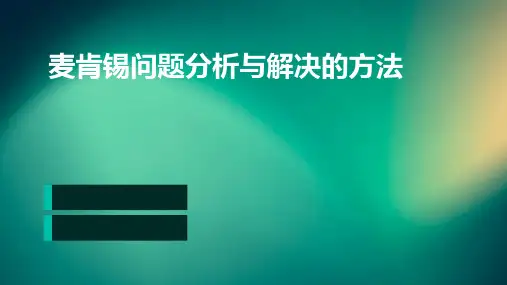
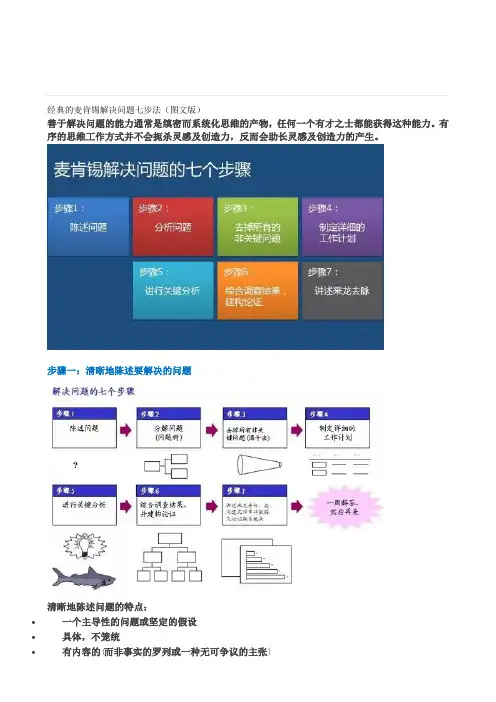
经典的麦肯锡解决问题七步法(图文版)善于解决问题的能力通常是缜密而系统化思维的产物,任何一个有才之士都能获得这种能力。
有序的思维工作方式并不会扼杀灵感及创造力,反而会助长灵感及创造力的产生。
步骤一:清晰地陈述要解决的问题清晰地陈述问题的特点:•一个主导性的问题或坚定的假设•具体,不笼统•有内容的(而非事实的罗列或一种无可争议的主张)•可行动的•以决策者下一步所需的行动为重点首要之务是对问题的准确了解步骤二:分析问题切勿低估团队合作对解决问题的价值步骤三:去掉所有非关键问题!步骤四:制定详细的工作计划工作计划的最佳做法:•提早:不要等待数据搜集完毕才开始工作•经常:随著反复仔细分析数据而修改、补充或改善工作计划•具体:具体分析,寻找具体来源•综合:同项目小组成员一起检测,尝试其他假设•里程碑:有序地工作,使用80/20方法按时交付步骤五:进行关键分析需遵循的原则:•以假设和最终产品为导向,不要只拘泥于数字-要题问“我要回答什么问题?”•经常反复地进行假设和数据分析,不要绕圈子•尽可能地简化分析,不轻言使用大的线性计划之类的工具•仔细分析之前估算其重要性,开阔视野,不要「见树不见林」•使用80/20及简便的思维方法,别钻牛角尖•从专家那里得到数据,经常给出比“图书馆数据”更清晰的指导方向•对新数据采取灵活态度同项目小组共享良计•对困难有所准备,勇于创新尽可能选择简便的问题解决方式……并避免复杂,间接或推论的方法对准「够精确」的目标即可,不需完美寻找明显事物一定要充分利用其他人的经验……并设法找专家来导引你的分析工作进行检查以保证结论同事实相符……随着迹象的增多,准备重新修改你的假设放眼未来,迎接分析方面将遇到的困难…同项目小组共享良计永远寻找开创性的方法…仔细将你的工作纪录成文件步骤六:综合分析调查结果,并建立论步骤七:说故事(陈述来龙去脉)准备故事图解:画出你所持论点的完整结构,以每张图表上方的讯息文字串连成一个合乎逻辑又具说服力的故事。
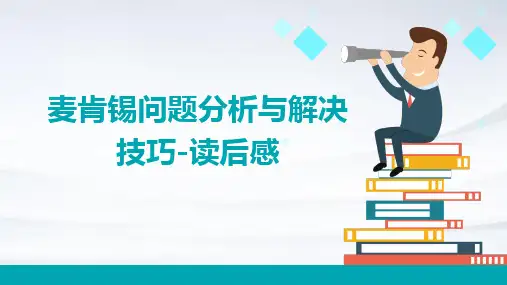

麦肯锡结构化表达案例主要涉及的是如何将复杂的信息和观点以清晰、有逻辑的方式呈现。
麦肯锡的结构化思维强调在思考和表达时,要遵循一定的结构,使得信息更易于理解和记忆。
一个典型的麦肯锡结构化表达案例是“30秒电梯法则”。
这个法则源于麦肯锡的一个真实故事,讲的是一位项目负责人没有在电梯里的30秒内向客户清晰地解释项目情况,结果导致客户投诉。
麦肯锡从这个事件中吸取了教训,要求所有的顾问和管理者,无论手头的工作多么复杂,都必须在30秒内把问题说清楚。
这个法则实际上是在强调结构化思维的重要性,即要在有限的时间内,快速地理清思路,抓住问题的核心,以简洁明了的方式表达出来。
在结构化表达中,麦肯锡还提出了其他一些重要的原则。
比如,中心先行原则,即在一次沟通表达中,必须有一个明确的中心思想,并且这个中心思想应该出现在表达的开头部分。
上下对应原则,即任何一个层次上的思想都必须是基于下一层次思想的概括,同时对上一层思想提供支撑。
这些原则共同构成了麦肯锡结构化表达的基础。
通过学习和应用这些原则和案例,人们可以提高自己的思考和表达能力,使得自己的观点和信息更加清晰、有逻辑,从而更容易得到他人的理解和认同。
麦肯锡问题分析与解决技巧-5如何用“分析”发现问题第一部分,第5章发现问题是很重要的能力解决问题的原点在于“发现问题的存在”。
例行公事,就很难察觉问题存在。
发现问题最关键的是对变化要够敏感。
解决问题的出发点就是要积极发掘出问题所在。
问题必须靠自己找出来。
自己权限内的问题,才是能解决的问题。
要拥有大格局的视野,但别超出自己权责范围,以当事者的身份脚踏实地地解决问题。
问自己6个问题,便于判断问题类型。
“现状与期待的状况之间有无落差?”“现状有没有发生什么变化?”“是否觉得哪个部分进行得不顺利?”“是否有些事情未达标准?”“有没有哪些事情不是你原先期待的状态?”“若置之不理,将来是否会发生重大的不良状态?”SCQA分析法SCQA是一种能有效的发现问题和设定课题的架构。
SCQA是通过描述当事者的心理及状况,在发现问题的过程中,以设问的方式刻画出课题的问题接近法。
SCQA分析的第一步是预先确认当事者的具体形象,无论当事人是人还是公司。
第二步,描述当事者过去的经验、目前稳定的状态和心中的理想,以及未来的目标,S Situation 状况。
在S中可穿插对当事人的描述。
第三步,假设一个正在颠覆目前稳定状态的事件(事情进展突然变得非常不顺利、稳定状态中发生了严重的不良状态或障碍)。
C Complication 障碍。
第四步,用自问自答的形式来假设各种课题。
Q Question 课题。
第五步,A Answer 思考出Q的解答。
思考假设性的解答方案,伴随了筛选及评价替代方案。
由C诱发的Q是当事者的课题贴近本质的课题最重要选出最重要的疑问作为课题向客户做提案时的应用窍门提案型业务,针对企业顾客的问题提出可行的解决方案(solution)。
如何运用解决问题的技巧来掌握顾客的思虑?观点:提供解决方案、增加提案广度。
切中对方在乎的问题与课题符合对方的问题要点,是指提出的问题领域、问题类型、课题领域与对方一致。
对方问题意识不明确,依据对方需求追加提案对方连问题要点都没有,向对方说明问题领域,问题类型,课题领域对对方多重要。
麦肯锡问题分析与解决技巧
书中对问题的定义不仅是于适应于上班,而且适用于我们生活的各个方面,在生活中遇到各种各样的问题,都要以解决问题的思维模式来面对,而不是抱怨。
问题发生时,我们经常会犯下三种错误,否定状况,在错误的时机追究责任,对于状况产生现实性的评价,书中总结的非常到位,在日常生活中,我们常见的一些人在遇到问题的时候,不是想着去寻找解决问题的办法,而是在错误的时间追究责任,对别人产生抱怨,这种心态都不利于问题的解决,所遇到问题的时候,最好的应该是想好解决问题的办法。
书中举了很多例子来说明,当问题出现的时候我们该如何解决问题,与其等事情发生才慌慌张张的处理,不如事先做好准备才能作出正确的应对。
真正的问题解决者不会被动的处理已经显在化的不良状态,而是更积极地发现防范潜在型问题。
当事情出现与理想有偏差时,我们要把问题进行分析,将出现的问题分解为各个比较少的问题,区分出紧急,严重性或可能性等问题,然后制定这些问题的先后程序以及解决办法。
虽然学会解决问题的技巧很重要,但更重要的是问题解决者的心态,工作中我们常常会因为工作的压力、领导的要求而承受很重的心理上的重担而乱了方寸,因此面临的问题越大,就必须越冷静。
问题解决者在怎么精通解决问题的手法或是拥有相关领域的专业知识如果承受不了心理上的压力乱了方寸惊慌失措就无法正确处理好面临的问提,因此,唯有保持冷静,才有可能花费最大的能力进而解决问题。
As part of the interview process, we will ask you to discuss a business problem. As you work through the business case with your interviewer, you will also become better informed about our firm and the kinds of problems we solve.Most candidates enjoy the cases and the business issues they raise. Your approach to the case and the insights you reach will give you an opportunity to demonstrate your problem solving abilities and help us get a sense of your potential. The following questions are addressed in this section:Why we use case studiesHow you should approach the problemWhat we are looking forCase study tipsSome common mistakesIf you want to practice, please try our on-line case study.Why We Use Case StudiesYour ability to deal creatively with complex or ambiguous problems in unfamiliar businesses, to structure your thinking, and to reach sensible conclusions with the available facts in a short time is a critical skill as a consultant.Since no particular background or set of qualifications necessarily prepares you to do this, we've come to rely upon the case study as an integral part of our interview process. The case study gives us an opportunity to see how you think about problems and whether you can reach a well-supported conclusion.Back to TopHow You Should Approach the ProblemThe cases you discuss in each of your interviews will be different. Generally, they are based on the interviewer's professional experiences and will usually describe situations with which you are notfamiliar. For example, your cases might focus on deciding how a company should react to a new competitor or determining what attributes a company should look for in seeking a joint-venture partner.In addressing the case, it is important that you take a logical, well-structured approach and reach a reasoned conclusion. At a minimum, you should be sure that you:Understand the underlying problem and the question. Ask for clarification on points that you feel are unclear.Break the problem down into a logical structure. There may be several issues to be addressed in order to reach a conclusion.Address the issues one at a time. Focus on the most important issues first. Your interviewer may not expect you to get through all of them in the allotted time.Address important issues, not just ones you feel comfortable with. Candidates often focus too much on their own area of expertise rather than the important issues (for example, accountants focusing on the financial aspects of new product development without mentioning customers).Test your emerging hypotheses. Keep coming back to check that you are addressing the question you were asked.Request additional information. As you build an understanding of the problem, there may be more information that you need.Reach a conclusion. Synthesize your thoughts concisely and develop a recommendation.Back to TopWhat We Are Looking ForIn most instances there is no right answer to the problem. It is critical that you demonstrate your ability to think in a structured way and that you reach a reasoned conclusion that is supported by the evidence. Listen carefully to the scenario; if you miss critical information, it can affect your ability to solve the problem.During the case study, we look for evidence of your ability on a number of dimensions — logical reasoning, creativity, quantitative skills, business judgment (not business knowledge), pragmatism, and an ability to structure problem solving. We also look for evidence of intellectual curiosity and enthusiasm for typical consulting issues.It is equally important for us to get a sense that you are comfortable with our working style —learning from the emerging facts and developing revised hypotheses as more information becomes available. You should be receptive to new information and use it to push your thinking forward. When you are asked a question, you should refer back to any relevant information that's already been discussed, rather than answering it in isolation.Back to TopCase Study TipsListen to the problem. Make sure you are answering the question that you have been asked.Begin by setting a structure. Think of four to five sub-questions that you need to answer before you can address the overall issue.Stay organized. Finish one key question and arrive at a point of view before you go on to the next.Communicate your train of thought clearly. If you have considered some alternatives and rejected them, tell the interviewer what and why.Step back periodically. Summarize what you have learned and what the implications appear to be.Ask for additional information when you need it. But make sure that the interviewer knows why you need the information.Watch for cues from the interviewer.Don’t fixate on "crackin g the case." It is much more important to demonstrate a logical thought process than to arrive at the solution.Use business judgment and common sense.Relax and enjoy the process —think of the interviewer as a teammate in a problem-solving process and the case as a real client problem that you need to explore and then solve.Back to TopSome Common MistakesMisunderstanding the question or answering the wrong question.Proceeding in a haphazard fashion. For example, not identifying the major issues that need to be examined or jumping from one issue to another.Asking a barrage of questions without explaining to the interviewer why you need the information.Force-fitting familiar business frameworks to every case question, whether they are relevant or not, or misapplying a relevant business framework that you do not really understand, rather than simply using common sense.Failing to synthesize a point of view even if you don’t have time to talk through all the key issues, be sure to synthesize a point of view based on where you ended up.。